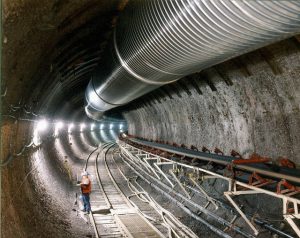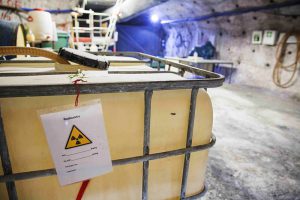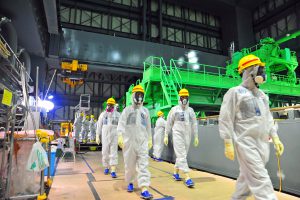On May 9th, emergency sirens went off at the Hanford Nuclear Reservation in Washington State, long considered the most toxic nuclear waste storage site in the United States. It’s where highly radioactive equipment from early nuclear weapon manufacturing was dumped along with the reactor fuel and core debris retrieved from the Three Mile Island meltdown in 1979.
Technicians reportedly noticed an unusually elevated level, roughly comparable to an x-ray exposure, while monitoring radiation at the decommissioned Plutonium Uranium Extraction (PUREX) Plant. This safety check, done before workers were due to start scheduled maintenance work, was fortuitous.
The cause of the small radiation spike was startling: a 20-foot section of the roof had caved in on an old storage tunnel adjacent to the PUREX plant. Inside were eight railway cars loaded with contaminated equipment from the 1950s.
Soil from a thick berm built over the tunnel fell directly into the hole and helped tamp down any radioactive dust. But managers could not determine exactly when the damage occurred. Aerial photos from March 2017 showed no sign of any impending collapse, but analysts worried that the hole might have been there for four days before anyone noticed.
Initially, nearly 5,000 Hanford employees were ordered to shelter in place and avoid eating and drinking, while a no-fly zone was temporarily declared over the facility. Since then, federal and state officials have repeatedly stated that no airborne release of radiation has been detected, although not all their monitoring data has been released to the public yet. Emergency crews in protective gear filled in the breach with 54 truckloads of clean sand and soil. An enormous plastic tarp, weighted with concrete blocks, will reinforce the roof repair until a more permanent fix is devised. "We could have an additional collapse of that tunnel," cautioned Doug Shoop, manager at the Department of Energy Richland Operations Office. This was quite a close call.
Public information
Breaking news about the damaged tunnel in Washington state was carried widely on US television, radio, newspapers, and online, but was not particularly prominent amid all the political turmoil being reported out of Washington DC.
Official government websites have been posting occasional updates, mostly underwhelming. This may be an attempt to minimise panic over an invisible but potent hazard. To focus on the perils of nuclear decay might reclassify it as a dirty power source and eliminate subsidies.
Former Texas Governor Rick Perry, who once proposed to eliminate the US Department of Energy, now heads it for the oil-friendly Trump administration. "I am pleased to announce that our dedicated and talented team of experts at the Department of Energy's Hanford site have completed filling in the hole discovered at the PUREX tunnel," Perry said in a statement.
"This was accomplished swiftly and safely to help prevent any further complications. Our next step is to identify and implement longer-term measures to further reduce risks…Thankfully, the system worked as it should and all are safe. The safety of our workforce, the communities and tribal nations that surround our sites, and the environment is my highest priority."
A legacy of waste
The Department of Energy is under increasing pressure to shift spent fuel away from reactor sites, especially since there already are 14 permanently shut American nuclear generating stations.
Out of the more than 70,000 metric tonnes heavy metal (MTHW) of spent fuel stored in the US, nearly 10% continues to be stored at permanently shut sites. For now, the bulk goes to Hanford.
Twice the size of Singapore, the enormous Hanford site is remote enough to be out of the public eye. The safe storage of ageing radioactive materials in its decaying tunnels is increasingly problematical. Radiation eventually will weaken the structures irreparably, and these improvised tunnels were never meant to be more than a stopgap solution.
Half a century has already passed. But these hot tunnels are only part of the picture. Out of a total of 177 storage tanks at Hanford, at least 67 tanks are leaking radioactive waste. Nearly 475 million gallons of contaminated water has been discharged to the soil. Some contaminants have even trickled into groundwater beneath the Hanford site. More than 80 square miles of groundwater is now dirtier than government groundwater protection standards allow.
One popular idea is to convert the millions of gallons of radioactive sludge into glass logs through a technique called vitrification. These logs are eventually destined for permanent storage deep underneath Yucca Mountain in Nevada. However, a proposed $17 billion vitrification plant for Hanford is fraught with safety concerns ranging from corrosion to explosion.
Meanwhile, the vast Yucca Mountain geological repository for nuclear waste appears to be a slow-starter. Former Nevada Senator Harry Reid, who served as Senate majority leader, blocked it for years. The Government Accountability Office admitted that the closure of Yucca Mountain was for political, not technical or safety reasons. What’s more, a recent GAO report now advises against vitrification, preferring to bind the waste in a cement-like mixture instead. It’s back to the drawing board once again.
Avoidable disaster
Although some 56 million gallons of radioactive sludge is stored here, alarmingly close to the Columbia River, the US$40 billion Hanford cleanup operation has been repeatedly delayed and is not expected to get underway until 2022, finishing in 2060.
For now, management is trying to prevent a catastrophe through manic maintenance. Postponing the inevitable will increase the cleaning charges by several magnitudes. Had things run on schedule, that pesky hole might just have been noticed in time. Meanwhile, hundreds of whistleblowers have come forward over the years to warn of slack safety standards and corner-cutting at Hanford. They have faced many obstacles.
If a future facility could be developed by a new independent organisation with direct access to the Nuclear Waste Fund, which is not subject to political and financial control like the Department of Energy is, there may be a way forward that doesn’t lead to catastrophe. Federal, state and tribal officials need to pursue it urgently.








![The Indus at the site of the proposed Diamer-Basha dam [image by: Water and Power Development Authority, Pakistan]](https://dialogue.earth/content/uploads/2017/05/Indus_Diamer_Basha_Dam_Site_Image_WAPDA-300x169.jpg)